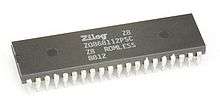Zilog Z8


The Zilog Z8 is a microcontroller architecture, originally introduced in 1979, which today also includes the eZ8 Encore!,[1] eZ8 Encore! XP, and eZ8 Encore! MC families.
Signifying features of the architecture are up to 4,096 fast on-chip registers which may be used as accumulators, pointers, or as ordinary RAM. A 16-bit address space for between 1 KB and 64 KB of either OTP ROM or flash memory are used to store code and constants, and there is also a second 16-bit address space which may be used for large applications.
On chip peripherals include A/D converters, SPI and I²C channels, IrDA encoders/decoders etc. There are versions with from 8 up to 80 pins, housed in PDIP, MLF, SSOP, SOIC and LQFP packages. The eZ8 Encore! series can be programmed and debugged through a single pin serial interface.
The basic architecture, a modified (non-strict) Harvard architecture, is technically very different from the Zilog Z80. Despite this, the instruction set and assembly syntax are quite similar to other Zilog processors: Load/store operations uses the same LD mnemonic (no MOV or MOVEs), typifying instructions such as DJNZ, are the same, and so on.
A free C compiler and IDE can be downloaded from Zilog's website.
Primary competitors include the somewhat similar[2] Microchip PIC family, and all the Intel 8051 descendants. Also more traditional "von Neumann based" single chip microcontrollers may be regarded as competitors, such as the 6800/6809 based Motorola 68HC11, the Hitachi H8 family, and Z80-derivatives, such as Toshiba TLCS-870, to name just a few.
Product line
- ROMless: Models without integrated ROM.
- ROM: Models with integrated ROM.
- BASIC: Models with integrated BASIC interpreter and debugger in ROM.
- OTP: Models with integrated OTP ROM.
- Low Voltage: Working voltage run as low as 2V.
- GP: General purpose microcontroller.
- Encore!: Integrated flash-based memory.
- Encore! XP: Encore! with sensors.
- Encore! MC (Motor Control): Motor control applications.
Emulators
A free software (GPLv3) Z8 emulator written in Java for Linux, Windows and OS X can be downloaded here: http://www.jens-mueller.org/jtcemu/download.html
Notes
References
- Grehan, Rick (September 1994). "Processors Proliferate". Byte.